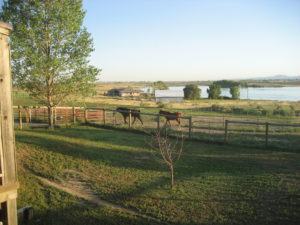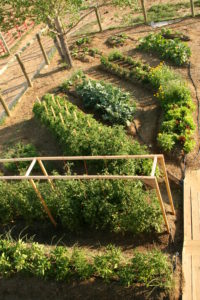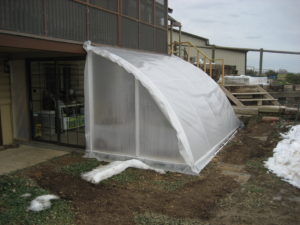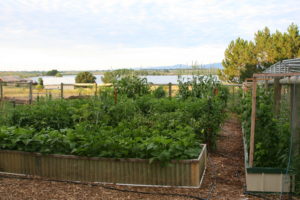OUR GARDEN HISTORY
 We (Tim & Laurie) were married in 2008, and so begins this story. At that time, Laurie moved from Tahoma, California (at West Lake Tahoe) to Tim’s property in Wellington, CO. Laurie had done a little gardening in Tahoma, at 6,300 feet elevation, mostly flowers and landscaping. Tim had done minimal landscaping and garden work there. Together, we decided we’d like to begin growing vegetables and fruits for our own consumption. In Wellington, we had 4 acres, at about 5,250 feet elevation, Zone 5b. The property already included a large fenced-in area on the south side of the house which we thought would be perfect for a garden. The horses could not get into this area and it was already fenced well enough to keep the bunnies out! This entire fenced area was about 4800 square feet of bare ground, with only some ground cover and weeds growing.
We (Tim & Laurie) were married in 2008, and so begins this story. At that time, Laurie moved from Tahoma, California (at West Lake Tahoe) to Tim’s property in Wellington, CO. Laurie had done a little gardening in Tahoma, at 6,300 feet elevation, mostly flowers and landscaping. Tim had done minimal landscaping and garden work there. Together, we decided we’d like to begin growing vegetables and fruits for our own consumption. In Wellington, we had 4 acres, at about 5,250 feet elevation, Zone 5b. The property already included a large fenced-in area on the south side of the house which we thought would be perfect for a garden. The horses could not get into this area and it was already fenced well enough to keep the bunnies out! This entire fenced area was about 4800 square feet of bare ground, with only some ground cover and weeds growing.
 Early 2009, during the winter, we got to work preparing for our garden. One side of this area had a bit of a slope to it, so Tim got busy terracing it with some old railroad ties. Our soil wasn’t good for growing vegetables–highly alkaline and clayey–so we knew we’d need to amend it a good deal. We had read about “sheet mulching”, and began preparing about 12 raised beds of various sizes, using the methods found in the book by Patricia Lanza, “Lasagna Gardening.”
Early 2009, during the winter, we got to work preparing for our garden. One side of this area had a bit of a slope to it, so Tim got busy terracing it with some old railroad ties. Our soil wasn’t good for growing vegetables–highly alkaline and clayey–so we knew we’d need to amend it a good deal. We had read about “sheet mulching”, and began preparing about 12 raised beds of various sizes, using the methods found in the book by Patricia Lanza, “Lasagna Gardening.”
 The bulk of our first year’s garden is shown here, at the left. Nice start, huh? We started an asparagus bed, some strawberries and herbs as perennials, and also grew tomatoes, peppers, cucumbers, peas, rutabagas, leeks, onions, broccoli, kale, a variety of lettuces, corn, beans, edamame, winter squash, summer squash & zucchini. We also attempted to grow some watermelon, celery and brussels sprouts, which didn’t do well.
The bulk of our first year’s garden is shown here, at the left. Nice start, huh? We started an asparagus bed, some strawberries and herbs as perennials, and also grew tomatoes, peppers, cucumbers, peas, rutabagas, leeks, onions, broccoli, kale, a variety of lettuces, corn, beans, edamame, winter squash, summer squash & zucchini. We also attempted to grow some watermelon, celery and brussels sprouts, which didn’t do well.
Tim prepared a grow bench with lights in our walk-out basement area, and I started many of my seedlings indoors, beginning as early as March. At first, I made many small newspaper pots to start the seedlings (shown in background below), but soon learned about soil blocks (shown in the foreground). After I began starting seedlings in the soil blocks I was convinced this was the way to go. We were on to something good. Read more about soil blocking here.
That first year our garden did very well overall. I (Laurie) began learning about canning, freezing and dehydrating, and of course we enjoyed plenty of fresh vegetables throughout the summer months. I especially loved having so many wonderful tomatoes. I learned to use the pressure cooker and canned as much as I could. We also got a dehydrator and froze what would do well in the freezer. We learned a lot and made plans to increase the garden size the following year.
 In 2010 we added about 10 more raised beds and included some raspberries, blackberries and honeyberries, along with 4 apple trees. We also began putting frames around the raised beds, which we hadn’t done the first year. We liked the framed beds much better than those without frames. To “raise” the beds, Tim used some metal roofing material we had on hand, and it worked out well. With the framed beds, we were also able to add a structure for a cold frame made with hoops & plastic covering, which we would be able to move to the various beds for a different location rotation each year.
In 2010 we added about 10 more raised beds and included some raspberries, blackberries and honeyberries, along with 4 apple trees. We also began putting frames around the raised beds, which we hadn’t done the first year. We liked the framed beds much better than those without frames. To “raise” the beds, Tim used some metal roofing material we had on hand, and it worked out well. With the framed beds, we were also able to add a structure for a cold frame made with hoops & plastic covering, which we would be able to move to the various beds for a different location rotation each year.
 In 2011, we added a greenhouse, one more large raised bed, and began raising our ducks. The greenhouse really helped extend our season. We were able to harden off our plants before planting outside, start a few cold-tolerant things earlier, and extend some things into the fall, like tomatoes. We also removed one of the garden beds which was just too hot in its location close to the south wall of the house. Things were just not growing well there; they cooked!
In 2011, we added a greenhouse, one more large raised bed, and began raising our ducks. The greenhouse really helped extend our season. We were able to harden off our plants before planting outside, start a few cold-tolerant things earlier, and extend some things into the fall, like tomatoes. We also removed one of the garden beds which was just too hot in its location close to the south wall of the house. Things were just not growing well there; they cooked!
 In 2012, we added another area of beds, an additional 375 square feet on the west side of the house. The total square feet of all our planted bed space combined was now about 1,400 square feet. This had become the ducks’ yard (see the red duck house in the background). The ducks and bunnies were kept out with the snow fencing, and this entire yard was fenced to keep the horses out.
In 2012, we added another area of beds, an additional 375 square feet on the west side of the house. The total square feet of all our planted bed space combined was now about 1,400 square feet. This had become the ducks’ yard (see the red duck house in the background). The ducks and bunnies were kept out with the snow fencing, and this entire yard was fenced to keep the horses out.
Throughout the years we tried different methods of watering, mostly using soaker hoses connected to timers. These worked well and were time-savers for us, but they did have a tendency to come apart, spring leaks and require frequent repair. We finally settled on using overhead sprinklers. The best option for us was an oscillating sprinkler placed on a tripod about 3’ off the ground. This was easily moved and could water about half the garden space at a time.
 In 2013 we viewed the “Back to Eden” video and began deep-mulching all of our beds with 4-6” of woodchips. For the most part we found this method successful, although because we found our woodchips from a variety of sources and did not know what kind of trees or bugs were in the chips, every bed developed different issues. Some had some strange fungus, but the biggest problem due to the woodchips was a woodlouse (woodlice, sowbug or pillbug) infestation in some of the beds. They loved the decaying woodchip environment, multiplied like crazy, and ate garden seeds such as peas and beans and small seedlings. I also found them in many of the tomatoes almost ready for harvest, especially those growing closest to the ground. Yeeesh. Hopefully they will not find my new garden!
In 2013 we viewed the “Back to Eden” video and began deep-mulching all of our beds with 4-6” of woodchips. For the most part we found this method successful, although because we found our woodchips from a variety of sources and did not know what kind of trees or bugs were in the chips, every bed developed different issues. Some had some strange fungus, but the biggest problem due to the woodchips was a woodlouse (woodlice, sowbug or pillbug) infestation in some of the beds. They loved the decaying woodchip environment, multiplied like crazy, and ate garden seeds such as peas and beans and small seedlings. I also found them in many of the tomatoes almost ready for harvest, especially those growing closest to the ground. Yeeesh. Hopefully they will not find my new garden!
 2014 was the final year of the garden in Wellington. Another successful year with lots of work canning, freezing, dehydrating & eating fresh vegetables. I still have a few canned and frozen goods left (it’s now early 2017). The woodlouse problem was not much of an issue this year; my theory is that during the first year those woodchips were just at the beginning of their decomposition, providing lots of food and a great breeding ground for the woodlouse. In the following year a great deal of the decomposition had already taken place and the food was not as plentiful for them, and perhaps those that remained froze to death. I’m no entomologist, I’m just guessing.
2014 was the final year of the garden in Wellington. Another successful year with lots of work canning, freezing, dehydrating & eating fresh vegetables. I still have a few canned and frozen goods left (it’s now early 2017). The woodlouse problem was not much of an issue this year; my theory is that during the first year those woodchips were just at the beginning of their decomposition, providing lots of food and a great breeding ground for the woodlouse. In the following year a great deal of the decomposition had already taken place and the food was not as plentiful for them, and perhaps those that remained froze to death. I’m no entomologist, I’m just guessing.
 During the garden years in Wellington we learned lots of tips and tricks through reading as well as through trial and error. I tried several methods of pest control, all organic in nature, some working better than others. The pests we found most annoying were the woodlice, squash bugs, cucumber beetles, aphids (especially in the greenhouse), and the last year, voles, who ate a large portion of my peppers (both hot and sweet).
During the garden years in Wellington we learned lots of tips and tricks through reading as well as through trial and error. I tried several methods of pest control, all organic in nature, some working better than others. The pests we found most annoying were the woodlice, squash bugs, cucumber beetles, aphids (especially in the greenhouse), and the last year, voles, who ate a large portion of my peppers (both hot and sweet).
The Wellington garden was documented in our blog, “Golden Gaits Garden”. That blog has been discontinued but is archived HERE.
With those years under our belts, we started our new, high-elevation garden and this website here in Guffey, and appreciate whatever the ground and future garden efforts bring forth.
